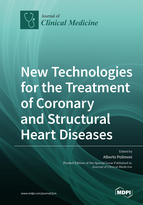New Technologies for the Treatment of Coronary and Structural Heart Diseases
A special issue of Journal of Clinical Medicine (ISSN 2077-0383). This special issue belongs to the section "Cardiology".
Deadline for manuscript submissions: closed (31 December 2019) | Viewed by 77633
Special Issue Editor
Interests: coronary physiology; coronary artery disease; atherosclerosis; acute coronary syndromes; atrial fibrillation
Special Issues, Collections and Topics in MDPI journals
Special Issue Information
Dear Colleagues,
There has been significant progress in the field of interventional cardiology from newer devices to newer applications of technology, resulting in improved cardiovascular outcomes. The goal of this Special Issue would be to update the practicing clinician and provide a comprehensive collection of original articles, reviews and editorials.
To this end, we would like to invite state-of-the-art reviews, including reviews of new technology and therapeutics, as well as original research in this area will be considered for inclusion in this issue. Examples include history and evolution of interventional techniques, reviews of specific devices and technologies for coronary artery disease (i.e., stent technology, atherectomy devices, coronary physiology, intracoronary imaging, and robotics), structural heart diseases (i.e., ASD: atrial septal defect; LAAC: left atrial appendage closure; MC: MitraClip; PFO: patent foramen ovale; TAVI: transcatheter aortic valve implantation), advances in the management of challenging coronary anatomy, new biomarkers of cardiovascular disease (Non-coding RNAs, etc.) and interventional techniques in the management of heart failure, peripheral arterial diseases and pulmonary embolism.
This Special Issue aims to present the most recent advances in the field of coronary and structural heart diseases, as well as their implications for future patient care. We look forward to your submissions!
Dr. Alberto Polimeni
Guest Editor
Manuscript Submission Information
Manuscripts should be submitted online at www.mdpi.com by registering and logging in to this website. Once you are registered, click here to go to the submission form. Manuscripts can be submitted until the deadline. All submissions that pass pre-check are peer-reviewed. Accepted papers will be published continuously in the journal (as soon as accepted) and will be listed together on the special issue website. Research articles, review articles as well as short communications are invited. For planned papers, a title and short abstract (about 100 words) can be sent to the Editorial Office for announcement on this website.
Submitted manuscripts should not have been published previously, nor be under consideration for publication elsewhere (except conference proceedings papers). All manuscripts are thoroughly refereed through a single-blind peer-review process. A guide for authors and other relevant information for submission of manuscripts is available on the Instructions for Authors page. Journal of Clinical Medicine is an international peer-reviewed open access semimonthly journal published by MDPI.
Please visit the Instructions for Authors page before submitting a manuscript. The Article Processing Charge (APC) for publication in this open access journal is 2600 CHF (Swiss Francs). Submitted papers should be well formatted and use good English. Authors may use MDPI's English editing service prior to publication or during author revisions.
Keywords
- Coronary artery disease
- Structural heart diseases
- Coronary anatomy
- Biomarkers
- Heart failure
- Peripheral arterial diseases
- Pulmonary embolism
- Interventional techniques







